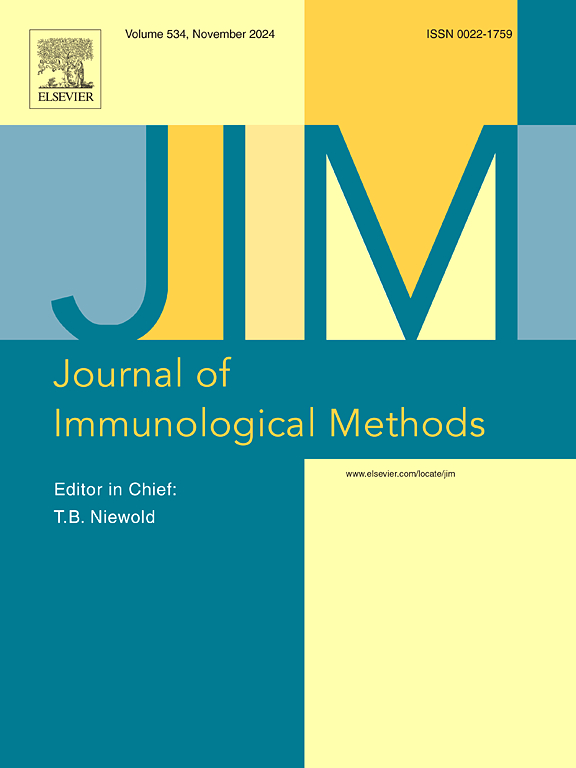Indirect ELISAs with sucrose subcellular fractions of Neospora caninum as antigens for diagnosis of neosporosis in cattle
IF 1.6
4区 医学
Q4 BIOCHEMICAL RESEARCH METHODS
引用次数: 0
Abstract
Neosporosis is one of the major causes of abortion in cattle, and it is responsible for significant economic losses in those animals. Thus, this study aimed to evaluate indirect ELISA using subcellular fractions of Neospora caninum obtained via sucrose gradient separation. Eighty-five sera from dairy cattle previously tested using indirect immunofluorescence assay (IFA) were used. Three distinct bands were separated at 1.0 M, 1.4 M, 1.6 M, and the pellet at 1.8 M, which were identified as fractions one (F1), two (F2), three (F3), and four (F4), respectively. These fractions showed parasite membranes in the F1, rhoptry and conoids in the F2, mitochondria in the F3, and tachyzoite ghosts remain in F4. Indirect ELISAs for IgM, and IgG were performed. Additionally, sensitivity, specificity, and kappa values were defined considering the IFA as the gold standard. The highest and lowest specificities were observed for F1 (76 %) and F3 (16 %), respectively. F2 and F4 showed the highest sensitivity (93.3 %), kappa agreement (0.46), and Negative Preventive Value (NPV) (73 %) respectively. It was possible to standardize indirect ELISAs using whole soluble antigen and subcellular fractions of N. caninum, and F2 and F4 showed higher sensitivity (93.3 %), kappa (0.41), and NPV values (75 %) than F1, and F3, which could be used for epidemiology studies such as screening.
使用犬新孢子虫蔗糖亚细胞分馏物作为抗原的间接酶联免疫吸附试验诊断牛新孢子虫病。
新孢子虫病是导致牛流产的主要原因之一,给这些动物造成了巨大的经济损失。因此,本研究旨在评估使用通过蔗糖梯度分离获得的犬新孢子虫亚细胞分馏物进行间接 ELISA 检测的效果。研究使用了 85 份奶牛血清,这些血清之前曾使用间接免疫荧光测定法(IFA)进行过检测。在 1.0 M、1.4 M、1.6 M 和 1.8 M 下分离出三个不同的条带,分别称为馏分一(F1)、馏分二(F2)、馏分三(F3)和馏分四(F4)。这些馏分在 F1 中显示寄生虫膜,在 F2 中显示跳虫和锥体,在 F3 中显示线粒体,在 F4 中显示速虫幽灵。对 IgM 和 IgG 进行了间接 ELISA 检测。此外,将 IFA 作为金标准,确定了灵敏度、特异性和卡帕值。F1(76%)和F3(16%)的特异性分别最高和最低。F2 和 F4 分别显示出最高的灵敏度(93.3%)、卡帕一致性(0.46)和阴性预防值(73%)。与 F1 和 F3 相比,F2 和 F4 的灵敏度(93.3%)、卡帕(0.41)和 NPV 值(75%)都更高,可用于流行病学研究,如筛查。
本文章由计算机程序翻译,如有差异,请以英文原文为准。
求助全文
约1分钟内获得全文
求助全文
来源期刊
CiteScore
4.10
自引率
0.00%
发文量
120
审稿时长
3 months
期刊介绍:
The Journal of Immunological Methods is devoted to covering techniques for: (1) Quantitating and detecting antibodies and/or antigens. (2) Purifying immunoglobulins, lymphokines and other molecules of the immune system. (3) Isolating antigens and other substances important in immunological processes. (4) Labelling antigens and antibodies. (5) Localizing antigens and/or antibodies in tissues and cells. (6) Detecting, and fractionating immunocompetent cells. (7) Assaying for cellular immunity. (8) Documenting cell-cell interactions. (9) Initiating immunity and unresponsiveness. (10) Transplanting tissues. (11) Studying items closely related to immunity such as complement, reticuloendothelial system and others. (12) Molecular techniques for studying immune cells and their receptors. (13) Imaging of the immune system. (14) Methods for production or their fragments in eukaryotic and prokaryotic cells.
In addition the journal will publish articles on novel methods for analysing the organization, structure and expression of genes for immunologically important molecules such as immunoglobulins, T cell receptors and accessory molecules involved in antigen recognition, processing and presentation. Submitted full length manuscripts should describe new methods of broad applicability to immunology and not simply the application of an established method to a particular substance - although papers describing such applications may be considered for publication as a short Technical Note. Review articles will also be published by the Journal of Immunological Methods. In general these manuscripts are by solicitation however anyone interested in submitting a review can contact the Reviews Editor and provide an outline of the proposed review.

 求助内容:
求助内容: 应助结果提醒方式:
应助结果提醒方式:


